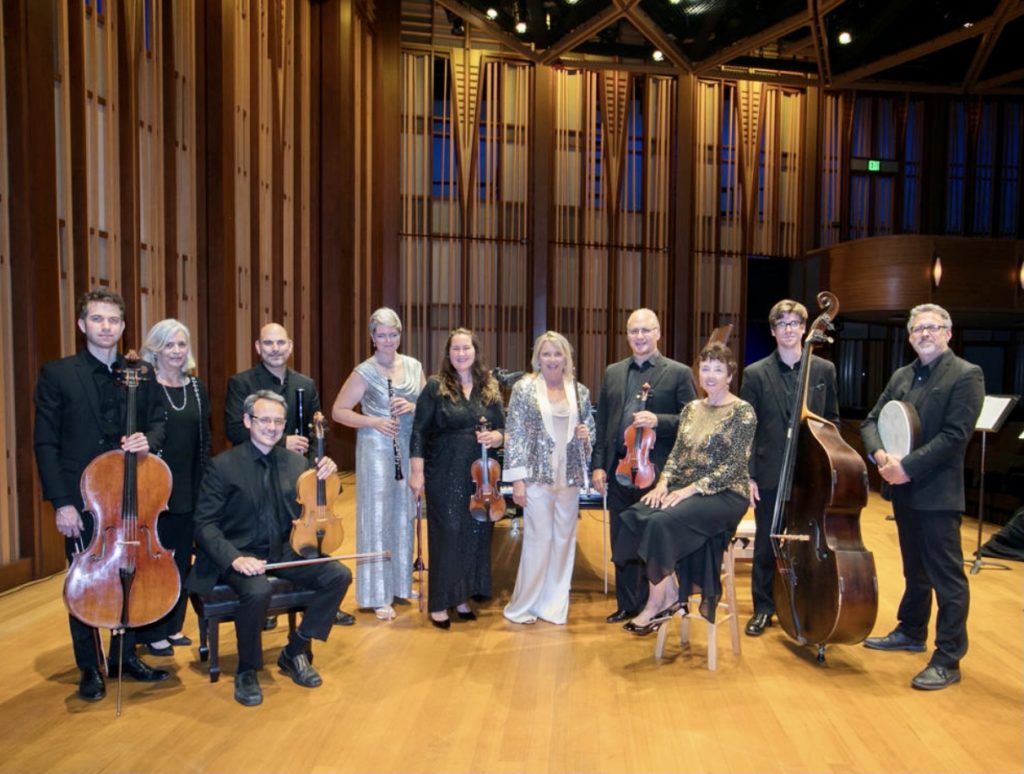Camarada’s Jewel Box of 18th-Century Gems
Camarada’s sparkling Tuesday performance in the Baker-Baum Concert Hall at The Conrad in La Jolla did more than Evoke the Baroque, the program’s clever title. In addition to celebrating that era’s superstars—Rameau, Purcell, Telemann, and Vivaldi—it boldly demonstrated how members of the next generation—C.P.E. Bach and Jean-Francois Tapray—drove the tradition into unexpected new directions. And for good measure, Camarada added a nostalgic bauble by the late contemporary guru of Italian film scores, Ennio Morricone.

Camarada (from left standing): Andrew Hayhurst, Dana Burnett, Ryan Simmons, Andrea Overturf, Briget Dolkas, Beth Ross Buckley, David Buckley, MacKenzie Leighton, Matt Armstrong; (seated) Travis Maril, Mary Barranger [photo courtesy of Camarada]
San Diego Symphony bassoonist Ryan Simmons gave an eloquent, beautifully detailed account of Vivaldi’s Concerto in C Major for Bassoon, RV 472, his burnished, velvety sonority undimmed in even the most athletic figurations. Telemann’s Concerto in E Minor for Flute and Oboe is more of a virtuoso showpiece than the Vivaldi—especially for the soloists—but flutist Beth Ross Buckley and oboist Andrea Overturf met every challenge with exuberance, finesse, and deftly balanced ensemble playing that belied the composer’s technical demands.
Telemann’s unusual four movement concerto structure, patterned after the Baroque church sonata, provided two dazzling fast movements, full of operatic drama amply supported by the strings. Each fast movement was introduced by a slow movement sporting an abundant catalogue of enchanting themes, supplied by Buckley and Overturf with stylish authority and opulent sonority.
By the time C. P. E. Bach wrote his double concerto for Harpsichord and Piano in E-flat Major, Wq 47, in 1788, the upstart fortepiano, invented in 1721 by the Italian craftsman Cristofori, had already overtaken the traditional harpsichord as the keyboard instrument of choice, especially in concerted music. It is possible to view this double concerto as Bach’s farewell to the harpsichord concerto genre—invented by his father—as the dialogue between the two instruments clearly gives the upper hand to the piano, although the composer provides each keyboard equal opportunity to shine.
At the harpsichord Mary Barranger’s insistent drive, crisp articulation, and agile lines made a great case for the harpsichord part, especially in the dazzling final Presto. Dana Burnett wisely underplayed the piano’s role, especially since she was playing a modern concert grand and not a period fortepiano; her effortless, lithe figurations complemented her keyboard partner, even though her listeners sensed how much musical horsepower she was reining in.
This 20-minute, three movement concerto with its profuse melodic invention provides great audience appeal, although C. P. E. Bach’s idiom—which we call the style galant—lacks the breadth of the later classical style that Mozart brought to such heights. Like the Nehru jacket, C. P. E. Bach’s lively style was once quite the rage, but when it had run its course, musicians put it in the closet and forgot about it.
A generation younger than C. P. E. Bach and a celebrated organist in his day, Jean-François Tapray paired the two keyboard instruments in a two movement Symphony Concertante for Harpsichord and Piano, a work I confess I have never before encountered. Bubbly and vivacious, this piece for just piano and harpsichord merged that dependable Baroque motoric drive with a facile vocabulary of short, snappy phrases that Barranger and Burnett engaged with the enthusiasm of a splurge at an elegant French patisserie.
Morricone’s “Gabriel’s Oboe” gave Andrea Overturf a chance to indulge the composer’s ravishing themes over lush string accompaniment—if this music had been a film score, no doubt we would have been watching two young lovers dreamily bicycling across a sun-drenched Tuscan countryside.
Camarada’s contingent of five strings, ably led by first violinist Bridget Dolkas, gave an ebullient account of a seven-movement Suite from Henry Purcell’s opera The Fairy Queen, Z. 629. Percussion additions by Matt Armstrong gave additional flair and urgency to Purcell’s terse, agitated movements.
Camarada performed this concert at The Conrad in downtown La Jolla to a live audience on Tuesday, 18 May 2021.

Ken Herman, a classically trained pianist and organist, has covered music for the San Diego Union, the Los Angeles Times’ San Diego Edition, and for sandiego.com. He has won numerous awards, including first place for Live Performance and Opera Reviews in the 2017, the 2018, and the 2019 Excellence in Journalism Awards competition held by the San Diego Press Club. A Chicago native, he came to San Diego to pursue a graduate degree and stayed.Read more…
